from:
Prestel museum guide, text by Denise Daenzer and Tina
Wodiunig: Native Museum of Zurich (orig. German:
Indianermuseum Zürich / Indianermuseum der Stadt
Zürich); Prestel edition; Munich, New York 1996;
supported by Cassinelli Vogel foundation, Zurich, by
MIGROS percent for culture, by Volkart foundation in
Winterthur; ISBN 3-7913-1635-4
<Pottery
[Superstition against
children during pottery production]
Pueblo natives of North American South West [natives of
today's New Mexico and Arizona, among others the villages
of Acoma, Hano, San Ildefonso with Zuńi and Hopi primary
nations (web01)] they are executing pottery generally only
by the wives when they have adult children. According to
Zuńi rules jug production is generally not allowed near
children's existance because screams of children can cause
a later destruction of the vessel.
Example
of ceramics of Hopi primary nation (today
above all New Mexico and Arizona)
|
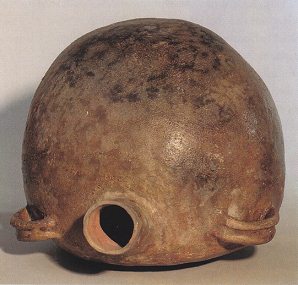
 Water tank of
village of Hotevilla of Hopi primary nation
(photo 2)
This typical water tank was made from ceramist
Cashongka in Hotevilla - a Hopi village on the
third Mesa - in 1934.
|
|
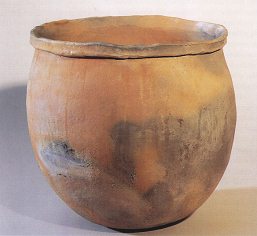
 Storage
vessel of Hopi primary nation (photo 3)
This daily
ceramic is from 1935 for storage of dried
plants.
|
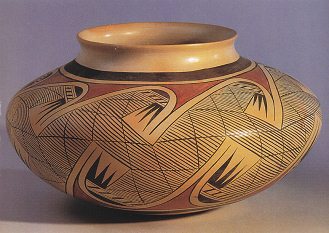
 Storage
jug from Pueblo Hano of Hopi primary nation
(photo 4)
This vessel
from 1940 was made by ceramist Fannie Nampeyo
from the village of Hano in a "Hano
Polychrome" style founded by her parents.
|
|
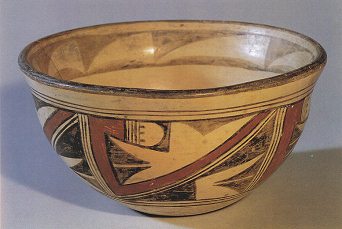

Polychrome clay bowl of Hopi primary nation
(photo 5)
This bowl
comes from a village on the first Mesa and was
made in 1920.
|
[Clay is a mixture of
chalk, sand, seashells or potsherds]
Clay is rated as a gift of Mother Earth, and therefore is
well appreciated. Clay is found by ceramists at
traditional locations often kept secret. For not being
destroyed during burning the clay has to dry first and
then has to be melt to be a fine powder, and then to this
powder are added melted chalk, sand, seashells or
potsherds.
[Pottery techniques]
One of the earliest pottery techniques was the claying of
a basket. During the burning process the netting was
burning completely and the clay form resisted. But this
form of pottery is not used any more today. Potter's wheel
was not known in pre Columbian times and also is hardly
used today. Little vessels are formed beginning with a
clay ball bringing out the right form with the fingers.
Production of bigger bowls is worked out in a coil-built
technique. As a pad mostly a flat bowl is used which can
be turned during the construction work. The clay rings are
added from the inner and outside and well prepared and
after short drying process also polished. Ceramists used
traditionally natural tools for that work, for example a
peace of pumpkin peel, a seashell, a potsherd or a
sandstone, today also a kitchen knife or sandpaper. There
is also a hammering technique working the walls of the
vessel with a hammer and an anvil which was spread above
all in the South East, but in South West of the continent
it was sometimes combined with coil built technique.
Normally the vessels for daily life are not painted and
are burnt as raw vessels. In former times only ceremonial
vessels were painted, today also objects for selling are
painted. Preparing the painting process the pores have to
be shut first with slurry, a mixture of water and colored
clay. Then the surface has to be polished using a soft
leather or a well polished stone. This well polished stone
was worth much so it was given many times as a heritage
from the mother to the daughter. Painting the clay was
done first with the fingers or using softened yucca rods
(softened in the mouth). Later paint brushes were
introduced. Painting work is executed also more and more
by men. Colors for pottery painting consist of mineral and
botanical substances. But painting of cheap pottery is
done with normal industrial colors. There are also relief
works before burning the vessel with modeling or carving.
[Burning techniques]
Burning process is only rarely in a kiln, but mostly on
fire open air with stones around it. First the pottery is
put on the place and then the wood, charcoal, dried dung
or bark was put around the vessels in layers. The burning
process was performed in an oxidation procedure with
oxygen circulating without obstacles, or with reduced
oxygen.
Also "black objects" of San Ildefonso are produced in a
reduced procedure: At the end of the burning process the
fire place is sealed up with dung material, and by this
carbon is set free which gives the typical black color
(photo 8/9).
Pottery
black in black from the Pueblos of San
Ildefonso (today in New Mexico)
|
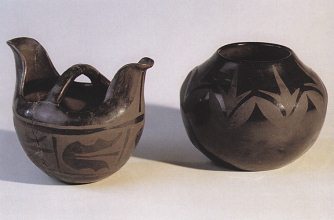
 Pottery
black on black of eastern Pueblos in San
Ildefonso (photo 8)
"San Ildefonso
Black-on-Black" (of eastern Pueblos): These
two signed objects are a further development
of "black ware". The jug to the left was made
of ceramist Isabel in about 1935, and the
handle pot to the right by Maria Martínez in
1931.
|
|
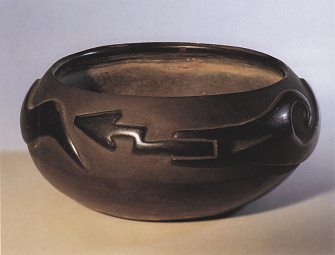
 Pottery
black on black of eastern Pueblos in San
Ildefonso (photo 9)
Black ware (of
eastern Pueblos): This bowl from the village
of San Ildefonso is signed with the name Jony
& Guanita. The bowl has got a relief
cornice of the feathered snake of Avanyu.
|
[Living pottery culture
in South West in Hopi village of Hano]
In 20th century are produced traditionally storage jugs,
pots for cooking, bowls and vessels, but also new objects
are made like candle stands or ashtrays. IN general
pottery culture of South West is living until today, also
because of the work of Hopi ceramist Nampeyo with her
husband Lesou from the village of Hano.
At the end of 19th century Lesou worked on an
archaeological excavation site in the Hopi territories.
From there one day he brought old potsherd from 14th and
15th century home showing them to his wife. These
potsherds were of the ceramic type of "Sikyatki
Polychrome". Nampeyo was absolutely fascinated of these
potsherds and copied some elements of them in her own
pottery work, and her husband was designing new designs
with them. This division of labor was soon copied in wide
regions of Pueblo pottery work. The collaboration of
Nampeyo and Leson gave as a result the so called "Hano
Polychrome style", and with this new style began a new age
for Hopi pottery. This development was supported by the
anthropologist Walter Hough who also worked for the
installation of a Hopi Trading Post in the Hopi
Reservation for selling the pottery. Hano Polychrome works
generally have no sludge coat and instead of it they have
a painting in red and black on the orange yellow base of
the burnt clay. The preferred Hopi designs are geometric
designs or very abstract illustrations of birds, feathers,
kachinas, clouds, flashes, rain and other elements playing
a role in their ceremonies.
[Ceramics of Zuńi primary
nation]
Also Zuńi pottery culture has reduced in the end of 19th
century by industrial made pottery. Zuńi before
concentrated their handicraft work in jewelry, and Zuńi
pottery until today [1990s] had no revival whereas
collectors appreciate it very well. The vessels of Zuńi
primary nation have often got a sludge layer on which are
painted the designs in black, brown or red color (photo
6).
Characteristic is a strong partition of the jugs in a body
section and a neck section with different illustration
designs. Mostly the neck section is ornamented with
repeated geometrical designs, and the body is well parted
into sections, sometimes interrupted by rosettes or
medallions. Such ornament work (p.46) was absolutely not
typical for south western cultures. So there is the
presumption that these are copies of embroidery designs
which were copied from Spanish altar clothes. Well loved
designs of this pottery culture are also birds, polliwogs,
frogs and other animals being in connection with the water
element.
[Animals with "heart
lines" with the idea for a better hunting]
Again and again also stags and other animals are painted
on Zuńi pottery showing a "heart line" in form of a red
flesh from the mouth to the region of the animal's heart
(photo 6/7). These heart lines are also called breath of
life or soul. They are symbolizing the magic influence
which a carnivore (bear, mountain lion or wolf) can have
against a wild animal (roe deer or stag). According to the
ideas of Zuńi culture the carnivores have got the capacity
touching the wild animals in their inner center by prayers
coming from their heart, and therefore the wild animals
will be their pray automatically. Native hunters are
wearing little stony fetishes and by this they try to
deviate a part of this magic animal force to the hunters
provoking more luck during their hunting.
Pottery
with animals and "heart lines" of Zuńi primary
nation (today New Mexico)
|
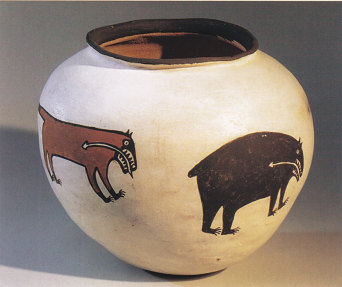
 Storage
jug of Zuńi primary nation with a bear and a
puma with heart lines (photo 6)
This vessel
was made in 1920 and is covered with bright
sludge on which two bears and a puma with
white heart lines are painted.
|
|
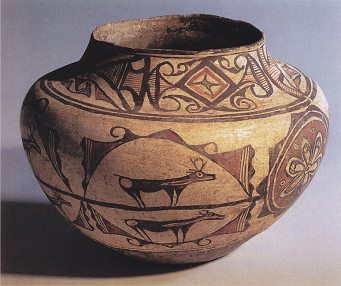
 Storage
jug of Zuńi primary nation with rosettes and
stags with heart lines (photo 7)
This jug from
1920 is ornamented with rosettes and stag
illustrations. The stags have got red heart
lines as a symbol for their breath of life.
|
[Pottery of Pueblos at
Rio Grande River]
Also in the Rio Grande Pueblos pottery was hardly dead in
1900. A new revival came up by the village San Ildefonso
in the 1920s by Maria and Julian Martínez. They got their
ideas first from the "black ware" which was made in Santa
Clara, and then they developed a new pottery technique
painting the designs with mineral color on a polished
clay. After burning the color was flat glimmering on the
well glimmering base. Teh vessels were burnt like the
"black ware" in a reduced burning procedure, but the
burning technique was more sophisticated yet by the
Martinez couple getting a more profound and more equal
coloring (photo 8). The same procedure which has become
famous under the name "San Ildefonso Black-on-Black" is
also worked Red-on-Red or Metal-on-Black. Also relief
modeled motives are well loved, mostly regular, geometric
designs which are more and more simple the more
industrialized the production was. The answer against this
trend came with personal signing of the handicraft pottery
works. Maria Martínez was the first person signing pottery
in 1923. She signed ceramics from South West and since
then is especially loved by collectors.
[Thin walled pottery with
sounds of the village of Acoma (today in New Mexico)]
Pottery technique of the village of Acoma is rated as the
most precious of South West. These vessels have got an
especially thin walled shape and are burnt in a way so
they became very hard, and therefore they give even a
sound tipping the finger on them. The former Acoma jugs
have mostly got designs in black on a white sludge layer,
and the lower part is without paintings. The designs can
be figurative or geometric, and the outer walls are full
of designs without partitions.
Ceramic
of the village of Acoma (today in New Mexico)
|
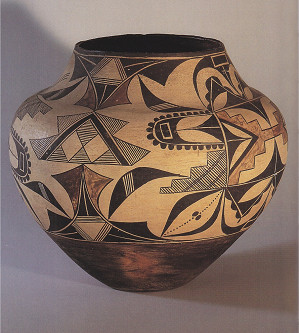
 Storage
vessel of eastern village of Acoma (photo 1)
This jug comes
from the village of Acoma and was made in
1920.
|
|
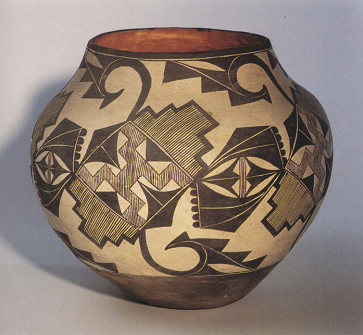
 Storage
vessel with designs of eastern village of
Acoma (photo 10)
This vessel
was made in 1920 in the village of Acoma which
is famous for it's finely worked ceramics with
especially thin walls.
|
[Pueblo ceramics with an
opening for the ghost of the pottering person]
All ceramics of Pueblo populations have got a specialty:
Every border line has got a little opening. By this
opening the spirit of the ceramist - or also the ghost of
the vessel itself - is entering the vessel and also
leaving it. Only this opening is the guarantee that the
ghost has not to stay as a prisoner in the vessel - until
the day that will be broken (p.47).








 Storage
vessel of Hopi primary nation (photo 3)
Storage
vessel of Hopi primary nation (photo 3)




